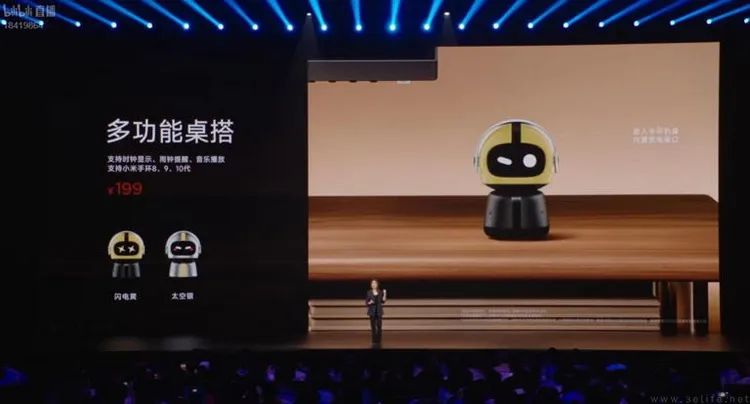
Read More《199元的小米桌搭机器人,“内涵”却绝不简单》
Positive Reviews: Dual Breakthroughs in Reviving Old Items and Ecological Integration – Xiaomi Sets an Innovative Example for the Industry
The “Multifunctional Desk Setup Robot” (hereinafter referred to as the “Desk Setup”) launched by Xiaomi is priced at only 199 yuan, but the product logic and ecological strategy behind it demonstrate profound user insights and technological innovation, providing a replicable model for the reuse of old items and ecological integration in the consumer electronics industry.
First of all, the “precise solution” for reusing old items addresses the pain points of both users and the industry. As low – priced and highly iterative wearable devices, there are two main reasons for users to discard old smart bracelets: one is the battery degradation that leads to shorter battery life, and the other is that the health monitoring function is replaced by higher – end smart watches or professional devices. Traditional solutions for reusing old items (such as converting old mobile phones into driving recorders or old tablets into speakers) often ignore the performance shortcomings of the devices themselves. Forcing new functions on them may lead to a fragmented user experience. For example, old mobile phones may not work for a long time due to heat dissipation issues, and old tablets may not be able to perform the core functions of smart speakers due to the lack of far – field voice pickup microphones and high – quality speakers. In contrast, the design of Xiaomi’s Desk Setup precisely avoids these shortcomings. By providing continuous power through built – in contacts, it completely solves the problem of battery degradation in old bracelets. In the “Desk Setup mode”, the bracelet is only used as a smart speaker with a screen, and the health sensors stop running, avoiding functional failures caused by old hardware. This reuse logic of “playing to the strengths and avoiding the weaknesses” not only retains the advantages of the old bracelet’s screen interaction (such as displaying clocks, lyrics, and cute expressions) but also avoids its shortcomings in health monitoring, truly giving the old device a “new life” rather than a “forced continuation”.
Secondly, the “cross – domain integration” of ecological device control lays a key foundation for Xiaomi’s full – scenario interconnection. For a long time, there has been a problem of “domain fragmentation” in the control logic of Xiaomi’s ecological devices. Sports and health devices (such as bracelets and watches) rely on the “Xiaomi Sports & Health” app, smart speakers, home appliances, etc. rely on the “Mi Home” app, and headphones, glasses, etc. have their own independent apps. Although this decentralized control system originated from the phased strategy of early ecological expansion, it has gradually become a pain point for users. Users need to switch between multiple apps, resulting in low operating efficiency. The emergence of the Desk Setup for the first time realizes the deep linkage between sports and health devices (bracelets) and the Mi Home app. When the bracelet enters the Desk Setup mode, all its functions (such as expression switching, clock setting, and music control) are managed through the Mi Home app. This seemingly minor breakthrough is actually of great significance. It not only verifies the technical feasibility of Xiaomi’s cross – category device control through hardware modules (Desk Setup) but also sends a clear signal of “integrating ecological control entrances in the future”. If Xiaomi can extend this logic to other devices in the future (such as connecting old watches to the Mi Home app to control home appliances), the user experience of its full – scenario interconnection will achieve a qualitative leap.
From an industry perspective, the innovation of the Desk Setup also echoes the global trend of the “circular economy”. As the consumer electronics market shifts from “incremental competition” to “stock operation”, how to activate the value of old devices in users’ hands has become the key for enterprises to enhance user stickiness and reduce resource waste. Through the combination of low – cost accessories (199 yuan) and software adaptation (system push for the Desk Setup mode), Xiaomi provides users with a “zero – threshold” solution for reusing old items, which not only enhances users’ goodwill towards the Xiaomi brand but also provides a reference path for the industry to explore “full – life – cycle management of devices”.
Negative Reviews: Be Alert to Compatibility Limitations, Incomplete Ecological Integration, and Potential Market Conflicts
Although the innovation of the Desk Setup is worthy of recognition, its current design still has several limitations that may affect the long – term release of user experience and commercial value.
Firstly, the “narrow coverage” of device compatibility may limit the user base. Currently, the Desk Setup is only compatible with Xiaomi bracelets of the 8th, 9th, and 10th generations. Older models of the 7th generation and below are not included due to interface or system limitations. Although this choice is understandable (newer bracelets have better hardware performance and lower adaptation costs), it also excludes a large number of users with old – style bracelets. For example, users of Xiaomi bracelets of the 7th generation need to purchase bracelets of the 8th generation or higher if they want to experience the Desk Setup function, which contradicts the original intention of “reusing old items”. In addition, users of non – Xiaomi brand bracelets cannot participate at all. This “ecological closed – loop” may weaken the market popularity of the Desk Setup. After all, the idle devices in users’ hands are not necessarily of the Xiaomi brand.
Secondly, the “hardware dependence” of ecological integration exposes the shortcomings of software capabilities. Although the Desk Setup realizes the linkage between the bracelet and the Mi Home app, its core depends on the physical contacts of the Desk Setup accessory (for power supply and communication), rather than the system integration at the pure software level. This means that if Xiaomi wants to connect other sports and health devices (such as watches) to the Mi Home ecosystem in the future, it still needs to use a similar “hardware bridging” method rather than directly achieving interconnection through the system’s underlying protocol. In contrast, Apple can allow devices such as iPhones and Apple Watches to directly control smart home devices through the “HomeKit” protocol without additional hardware. Huawei can also achieve seamless collaboration between devices through the distributed capabilities of the “HarmonyOS”. Xiaomi’s current “hardware – dependent” model reduces short – term development costs but may hinder the efficiency and flexibility of ecological integration in the long run.
Thirdly, the “potential conflict” between reusing old items and selling new products needs to be carefully balanced. The core value of the Desk Setup is to allow users to “keep their old bracelets and give them new functions”, but this may also weaken users’ motivation to buy new bracelets. For example, if users convert their old bracelets of the 8th generation into desktop devices through the Desk Setup, they may think that there is no need to upgrade to the 10th generation, which will affect the sales of new Xiaomi bracelets. Although the main upgrade points of Xiaomi bracelets currently focus on health monitoring (such as adding blood pressure and blood sugar monitoring functions), and the health functions are turned off in the Desk Setup mode, and the usage scenarios of the two are different, in the long run, if users form the perception that “old bracelets are sufficient to meet the needs of the desktop scenario”, it may still have a marginal impact on the sales of new products.
Advice for Entrepreneurs: Key Strategies for Stock Operation and Ecological Integration from the Perspective of Xiaomi’s Desk Setup
The case of Xiaomi’s Desk Setup provides multi – dimensional inspiration for entrepreneurs, especially in the fields of stock device operation and ecological integration. The following three points deserve special attention:
- To tap the value of stock devices, it is necessary to “precisely position the scenario + avoid the shortcomings”: Old devices in users’ hands are often idle due to performance degradation or outdated functions, but they are not completely worthless. Entrepreneurs need to conduct in – depth analysis of the “remaining advantages” of old devices (such as the screen interaction and low – power consumption features of Xiaomi bracelets) and match them with new user scenarios that have not been met (such as desktop smart devices). At the same time, they should use technical means (such as continuous power supply in the Desk Setup) to avoid their shortcomings (such as battery degradation). Avoid “reusing for the sake of reusing” and instead follow the principle of “user experience first” when designing reuse solutions.
- Ecological integration requires “software first + hardware assistance”: Although Xiaomi’s Desk Setup’s hardware – bridging model solves short – term problems, it needs to transform towards system integration at the software level in the long run. When entrepreneurs are planning their ecosystems, they should first build a unified device protocol and control framework (such as Huawei’s distributed technology in HarmonyOS and Apple’s Matter protocol), allowing different types of devices to be directly interconnected through software rather than relying on additional hardware. Hardware can be used as a supplement (such as the “form innovation” of the Desk Setup) but should not be the core path for ecological integration.
- Balance the relationship between old and new products and clarify the “separation of usage scenarios”: Reusing old items may compete with the sales of new products. Entrepreneurs need to resolve this conflict through the “separation of usage scenarios”. For example, Xiaomi’s Desk Setup limits the usage scenario of old bracelets to “desktop smart devices”, while the core scenario of new bracelets is “wrist – worn health monitoring”, and the functions of the two do not overlap. Entrepreneurs can learn from this idea and design scenarios for old devices that are “complementary rather than substitutable” to new products, which can not only activate stock users but also not affect the growth of new product sales.
In conclusion, Xiaomi’s Desk Setup is not only a “small and beautiful” accessory product but also an important practice for enterprises to explore stock operation and ecological integration. Its success lies in the precise grasp of user pain points and the forward – looking layout of industry trends, while the exposed limitations provide key references for entrepreneurs on “how to avoid detours”. In today’s consumer electronics market, which is shifting from “incremental competition” to “stock operation”, innovative ideas like the Desk Setup may become a new determining factor in enterprise competition.
- Startup Commentary”The Incomplete Evolution History of Bathing Centers”
- Startup Commentary”Starting from 358,800 yuan, Maserati Slashes Prices Drastically to Survive”
- Startup Commentary”Monopoly: Always the Best Business”
- Startup Commentary”A PE Giant Spent $6.6 Billion on a Crematorium”
- Startup Commentary”In a Low-Sports Year, Social Assets Still Hold Great Value”





